Home > Articles > The Archives > The Bluegrass Music Hall of Fame & Museum
The Bluegrass Music Hall of Fame & Museum
Reprinted from Bluegrass Unlimited Magazine
August 2018, Volume 53, Number 2
The new $15 million Bluegrass Music Hall Of Fame & Museum is set to open October 18 this year. After a $100 million riverfront rebuild, Owensboro, Ky., is a new city and destination. To borrow an oft-used phrase, in the minds of bluegrass lovers, the story of Owensboro is now the proverbial “tale of two cities.”
Owensboro is where the International Bluegrass Music Association (IBMA) got its start in the mid-1980s, and it’s also the city where the first IBMA World Of Bluegrass conventions and Fan Fests took place until they moved to Louisville in 1997. Back then, the Executive Inn Rivermont was ground zero for all things bluegrass, and to this day, you still hear stories about the World Of Bluegrass events that took place there. Now, however, everything has changed. Let the word be sent forth.
Tear Down of the Big E
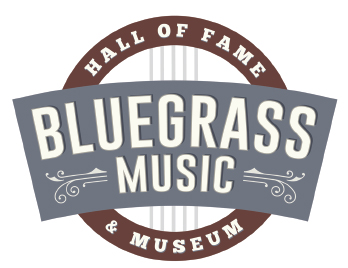
Known as “The Big E,” the Executive Inn Hotel quickly aged and became nearly obsolete in the years after the bluegrass conventions left town. To further make this point, there is a review of the Executive Inn on Trip Advisor from 2008 that describes the hotel in its later years as, “A joke! My stay at the Executive Inn of Owensboro, Ky., was atrocious! To be called a so-called luxury hotel, it was more like a Motel 6. The food was awful, as well as the accommodations. The rooms are outdated, ditty, and the AC didn’t even work. The prime rib buffet was a joke. I’ve had a better salad bar at Pizza Hut. The boiled eggs were actually frozen. The room smelled, the carpet was filthy, the bedspread was worn and stained, and the front desk help was no help.”
Folks, the Executive Inn is no more. It was bought and demolished and no longer exists. It’s now time for the old images of Owensboro to disappear with it, and here’s why. In what has been an impressive and bold endeavor, the entire riverfront area of Owensboro has been given a multi-million dollar facelift that has made it a different place entirely and turned it into a revitalized jewel on the mighty Ohio River. And, bluegrass music is at the center of it.
Before the story is told, it’s time to clear the air and erase the mental image of the Owensboro of yesteryear. Here are the bullet points: 1.) Less than a decade ago, the city received a $40 million grant from the Federal Government to save and fix its riverbank, which was being badly eroded by the Ohio River. 2.) Once it was known that the riverbank would be saved, the City of Owensboro, Daviess County, a group of business leaders and entrepreneurs, local taxpayers, and the State of Kentucky worked together to take advantage of the newly rebuilt area to create a whole new riverfront district. 3.) As a result, the new riverfront district features a thoroughly modern $48 million, 169,000 square-foot Convention Center, multiple new high-end hotels, six riverfront music stages that augment large multi-use gathering spaces, dancing fountains, a large and impressive 3-D playground for kids, and the RiverPark Center for the Performing Arts, all on a mile-long stretch on the reclaimed banks of the Ohio River. 4.) Anchoring this impressive riverfront district is the brand new $15 million dollar, state-of-the-art Bluegrass Music Hall Of Fame & Museum, which is set to open its doors on October 18, 2018. The facility has also worked hand-in-hand with the IBMA leadership to create something truly special.
A New Day for Owensboro. A New Day for Bluegrass.
Owensboro became the birthplace of the IBMA organization in 1985 and has been the home of the separately-run Bluegrass Hall Of Fame & Museum since 1991. Local businessman Terry Woodward was a part of the creation of the IBMA and was on the organization’s first board of directors along with Keith Case, Eugenia Snyder, Mary Doub, Barry Poss, Milton Harkey, Larry Harrington, Art Menius, Larry Jones, Allen Mills, and Bluegrass Unlimited’s own Pete Kuykendall. In the years since the World Of Bluegrass convention left Owensboro, eventually making its way to its current location in Raleigh, N.C., Woodward has continued to be a big part of the development of his home city.
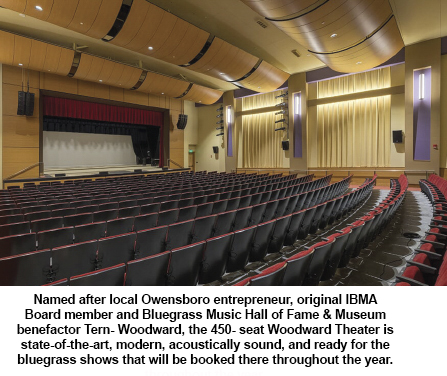
After it was determined that the shores of the Ohio River would be restored and ready for development, the city made the smart move of forming a committee to go and visit another city that had turned their riverfront locale around. The destination of choice was none other than Dubuque, Iowa. Dubuque has become a success story in recent years, turning its riverfront district and surrounding region into a burgeoning tourist destination. The goal of the Owensboro committee was to find out what worked and what didn’t work for that Mississippi River town that has changed course for the better.
“‘The Federal Government gave Owensboro $40 million to redo our riverbank because it was eroding, and we had lost a lot of land,” Woodward said. “So people began to think, ‘Well, this is a great opportunity to do something unique, rather than just put a wall out there and fill in some dirt/ We had never taken advantage of this beautiful Ohio River. The Executive Inn was in disrepair, and it was going under and was dilapidated. So, we elected a mayor about ten years ago named Ron Payne that had a vision for downtown Owensboro. They bought the old Executive Inn and tore it down and put in the new Convention Center in its place. After he got elected, he really went to work on redoing downtown.” Then came the visit to Dubuque.
“When the committee went to Dubuque, they saw that the city had built a new riverfront, a new convention center, and the National Mississippi River Museum & Aquarium,” Woodward said. “What the committee told Mayor Payne and the delegates was what made everything work in Dubuque was the museum. That’s what brought the tourists in. The folks in Dubuque told them, ‘If you have anything about your town that you can claim and you can brand it and build a museum around it, do it.’ Everybody turned around and looked at each other and said: Bluegrass. The committee and Mayor Payne came down one day and asked me if we would be interested in moving the museum to the riverfront and making it bigger and more than a museum—to make it an event center. Mayor Payne said, ‘We will give you three million dollars and the property.’”
After a study was done, it was determined that much more than $3 million dollars was needed to make a truly impressive bluegrass museum. Woodward headed up a group that raised over $5 million dollars. But, when they tried to retrofit the existing building that was on the donated property, it just didn’t work. It was like trying to fit a square peg into a round hole. Ultimately, the price tag for an all-new building rose to $15 million, and that is when a trip to see (then) Kentucky Governor Steve Beshear was planned.
“Mayor Payne and I went to see Governor Beshear and, on the first trip, he pretty much said a flat ‘no,’” Terry recalled. “On the second trip to see the Governor, he said ‘maybe.’ Then, Governor Beshear sent his whole cabinet to Owensboro—folks representing Transportation, Tourism & Economic Development—and Ron and I made a presentation about the economic impact it would have, not only on Owensboro, but also on the State of Kentucky. Owensboro and the Bluegrass Music Hall Of Fame & Museum will be a draw for the whole state because we are also on the Kentucky Bourbon Trail. The head of tourism was impressed because we had our ducks in a row, we already had an existing museum, and we had raised millions of dollars. Then Governor Beshear called Mayor Payne, the city manager, and myself up for a meeting. He said, ‘Guys, I’m going to give you your $5 million.’ The state gave us $5 million, I raised $5 million and the City of Owensboro gave us $5.4 million.”
After the City of Owensboro used the Federal Grant to move the river walls further out into the Ohio River to gain a lot of the land back, construction on the Riverfront District began.
The Museum Belongs to Everyone
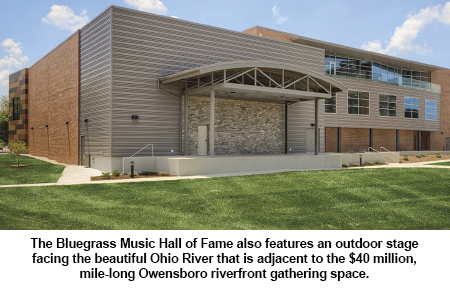
The $15 million raised was put to great use. When the museum opens, it will be a multi-use facility featuring a Hall Of Fame dedicated to the bluegrass music founders and other exhibits and multi- media displays designed to tell the story of bluegrass and all of its roots and branches up until the present. It will also feature the beautifully-adorned 450-seat Woodward Theater built for concerts and events, an outdoor stage facing the Ohio River, top-of-the-line dressing rooms for visiting entertainers (including a modem and spacious shower and a washing- machine and dryer), and event spaces to be rented out that showcases the splendor of one of America’s great waterways. With concerts scheduled all year long and the facilities topnotch in their design, the new museum will be a living, breathing structure full of activity.
Chris Joslin is the Executive Director of the museum and has overseen all of these exciting developments. “I took this job because I felt like all of the ingredients were there and the timing was right both for bluegrass and for the City of Owensboro,” he said. “Once I was reacquainted with Owensboro, the riverfront, all of the downtown development, the new Convention Center, and all of the private development going on, I realized good things were happening. Especially when we learned that this new museum was going to be situated on the best piece of real estate in town. Then, when I saw that the new museum was going to be adequately funded and I saw the design of the new building and realized it was going to be a part of a bigger story here in Owensboro, I thought that they needed someone to come in with some leadership and business skills that was also a part of the bluegrass community. I knew I was going to bring a ton of passion to this job, someone who was going to enthusiastically wake up every day and work to put some skin on the bones of this project.”
Joslin was raised in Nashville and began playing banjo when he was ten years old. He played in touring bluegrass bands up to his college years. After he received an MBA from Belmont University, he entered the corporate world as a successful recruiter and talent headhunter. In fact, he was hired to be a part of the effort that brought Paul Schiminger on board as the current Executive Director of the IBMA. When the job of Executive Director for the museum came open, Joslin felt like it was a dream job for him in many ways because he was already a part of the bluegrass world.
The new museum will celebrate the origins of bluegrass music, its first generation legends and more while also acknowledging the journey that the genre has taken up to the twenty-first century.
“This was a great opportunity to showcase and embrace the new generations of bluegrass music by being a cultural center as well as a bluegrass history center that takes everybody back to the source of bluegrass music,” Joslin said. “Let’s celebrate where we are now in bluegrass and where it’s going, but let’s also not forget the original bluegrass story. The bluegrass music narrative is rooted in time, place, and people and it’s an incredible tale. Bill Monroe was born right down the road from here, so we are truly close to the source here in Owensboro. We are proud to be the home of the Bluegrass Music Hall Of Fame & Museum where all of those creators are honored.”
There will be exhibits in the museum that will rotate and change as time goes by, much like what is done at the Rock & Roll Hall Of Fame in Cleveland, Ohio, and the Country Music Hall Of Fame in Nashville, Tenn. In fact, for tourists who love music, there’s talk of a Museum Trail being created for those who want to visit all three institutions as they exist in a triangle of adjoining states.
“The core exhibits in the museum tell the story of bluegrass chronologically, starting with the sources of the music and essentially trying to answer the question of what influenced Bill Monroe and Flatt & Scruggs and those first generation folks,” Joslin explained. “We talk about Scottish and Irish fiddling, the blues and Arnold Shultz, gospel music, the jazz music of the day, Jimmie Rodgers, and everything that came out of Bristol in 1927, and all of the music that was stirring in the 1920s and 30s. Then, we get into Bill Monroe becoming a star on the Grand Ole Opry and creating that first classic bluegrass band with Howard Watts, Earl Scruggs, Lester Flatt, and Chubby Wise. Bill Monroe had finally got his ‘dream team’ together. The Stanley Brothers were also soon making great records and eventually so was Flatt & Scruggs. So, we cover the dawn of the bluegrass era.”
The exhibits in the museum move on from there, acknowledging the hard times the genre went through during the rock-and-roll revolution, the festival period that changed bluegrass in so many ways, and so much more up to the present scene of today. The exhibits are created to appeal to the current, modem-day music lovers of all stripes who will be strolling through the premises.
One multi-media display, for example, interviews bluegrass veterans such as Ricky Skaggs and Del McCoury, as well as younger artists such as Sierra Hull and Billy Strings, so all generations are represented. Another aspect sure to entice and please visitors will be the official picking room. With such a large number of every day bluegrass fans who are players in their own right, this room will be ripe for jamming.

“We affectionately call it the Picker’s Corner because one of the first things you’ll see when you walk through the museum is a wall of instruments including banjos, guitars, fiddles, mandolins, resonator guitars and basses,” Joslin said. “All of these professional-level instruments are not only an exhibit, they’re also meant to be played by those who visit the museum, whether you’re a beginner or a pro. We’re not going to be picky about who plays these instruments. We’ll make sure they are tuned and have fresh strings on them and are ready to go. There will be pickin’ chairs available as well. The first thing you see when you walk through the door is instruments. A lot of people who will make the pilgrimage here will be good musicians, so we want to encourage them to make music for as long as they want to play. You know how it goes. Sometimes the person who delivers your UPS package is also a phenomenal musician. That’s what I love about bluegrass music.”
Some of the companies that have donated instruments to the wall in the Picker’s Corner include Martin Guitars, Nechville Banjos, Eastman Guitars, Deering Banjo Company and more. Encouraging people from all generations to actually learn how to play music is also a main focus of the museum.
“At the center of our mission is education, so we’ll feature a lot of educational programs at the museum,” added Joslin. “Even now, we have about 260 people of all ages enrolled in our Saturday Music Lessons program, from six years old to folks in their eighties. Our Education Director, Randy Lanham, also takes the Bluegrass In The Schools program to every elementary school in Daviess County, reaching over 9,000 students a year. Randy is a phenomenal fiddler and a great musician and has a real heart for students and teaching, and he’s out there in the field working with music teachers. We reinforce all of that in the schools by bringing in a touring band that does an assembly program at every elementary school in the county. We even have an Instrument Loan program, so if a student wants to take a crack at learning to play the mandolin, we can loan them a mandolin. Adults can borrow instruments as well. The museum also hosts open jams on a regular basis where players of all levels can become a part of the bluegrass community.”
The connection between the IBMA and the Bluegrass Music Hall Of Fame & Museum is better than ever. Paul Schiminger is happy with the results and has enjoyed his important role in this adventurous collaboration. That includes moving forward with the special one-time induction of five worthy musicians into the Hall Of Fame that will happen at the October 18th Grand Opening, separate from the IBMA Awards Show in September. You can find more information on that event in our sidebar article.
“IBMA’s relationship with the museum is extremely close,” Schiminger said. “Chris Joslin and I are completely aligned together so we can help each other and help bluegrass music. The Bluegrass Hall Of Fame & Museum was started many years ago and, even now, our mantra and focus is still to honor tradition and to encourage innovation. The goal to honor tradition is a perfect partnership with the museum. They are housing [IBMA’s] Hall Of Fame and we work closely to promote the music together, and both organizations and bluegrass music is better off for it.”
Schiminger has seen the new museum and is very impressed with it. “The new building is amazing and it’s a dream for all of us to have a place like this museum for our music,” he said. “And, it’s in such a perfect position within Owensboro, to shine that light on bluegrass, as it’s right there on the riverbank where a lot of the new development has occurred. It will gain a lot of attention from visitors and locals, and more people will be drawn to it than ever before. It’s extraordinary what they’ve done there, as we’re seeing the revitalization of an entire city. There is this injection of energy that will mix in with the traditions that have been there all along. They’re creating this great mixture that will pump more energy into bluegrass music.”
With this impressive multi-million dollar structure now in place, there is now a renewed call for historical bluegrass music artifacts to be donated or loaned to the museum for permanent display, as well as rotating future exhibits soon to come.
Owensboro now touts the four “Bs”—Bourbon, BBQ, Bluegrass, and Boats. With the new Glenmore Distillery in town producing libations, Owensboro is now officially a stop on the Kentucky Bourbon Trail which brings in over a million tourists a year on its own. The city is also known for its famous BBQ mutton, which you can find at the renowned Moonlite Bar-B-Q Inn, an establishment that has been around for over 50 years. There are also many other BBQ establishments in town that are adding their own contribution to the Owensboro BBQ scene as well, making it a truly unique culinary experience.
With the Ohio River now playing such a prominent role, there are tour boat owners originating in Cincinnati and elsewhere that are putting together wonderful overnight boat tours in the near future to Owensboro to take in everything it has to offer. Owensboro also hosts the successful ROMP Festival, a music festival that regularly brings in over 10,000 music fans every year. That event has become yet another important piece of this amazing bluegrass puzzle and city development happening in northwestern Kentucky.
Another event to think about when timing your trip to Owensboro and the museum is the Friday After Five street gathering that happens every week from Memorial Day to Labor Day. All along the impressive mile of reclaimed riverfront are six stages of live music, adult beverages, food trucks, fun for the kids, and so much more.
As the autumn leaves begin to him, if you ’re planning a road trip later in the year or beyond, or if your organization is looking for a fresh and fun place to hold their convention, Owensboro is your new destination. And at the center of it all is the Bluegrass Hall Of Fame & Museum. (More information can be found at www.bluegrassmuseum.org,www.ibma.org, and www.visitowensboro.com.)
IBMA Hall of Fame Inductees
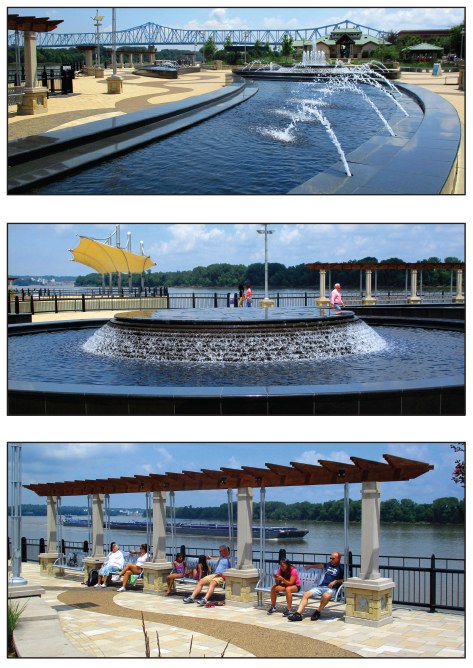
Five new members of the IBMA Hall Of Fame will be inducted at the Bluegrass Hall Of Fame & Museum Grand Opening in October. The weekend will also feature live music by Sam Bush, Town Mountain, Front Country, and Yonder Mountain String Band. When the museum opens to show the world all of its $15 million splendor, it will be a special occasion for many reasons. The three-day event in revitalized Owensboro, Ky., will feature a onetime ceremony that will induct five deserving bluegrass artists into the IBMA Hall Of Fame. These honorees will be separate from the three Hall Of Fame inductees to be given tribute at the annual IBMA World Of Bluegrass Awards Show on September 27th in Raleigh, N.C. The five artists scheduled to be inducted on October 18th are Vassar Clements, Joe Val, Mike Seeger, Allen Shelton, and Jake Tullock.
“The night of October 18th will be a gift to the Hall Of Fame members and their families, as well as for the families of those Hall Of Fame members being inducted posthumously that evening,” said Chris Joslin, Executive Director of the Bluegrass Hall Of Fame & Museum. “It will also be a night for donors, contributors, and other stakeholders who kept the new museum dream alive and ultimately made it happen. If there are unused seats, they will certainly be available to the public. To make it easy for current Hall Of Fame members and other artists to participate musically on that Thursday evening, we’ve assembled a crackerjack house band that includes Mike Bub on bass. Sierra Hull mandolin, Stuart Duncan on fiddle, Charlie Cushman on banjo, Tim Stafford on guitar, and Josh Swift on resonator guitar.”
On Friday, October 19, there will be a ticketed concert at the museum by the Sam Bush Band. On Saturday, October 20, there will be a very special free concert on the museum’s outdoor stage facing the Ohio River that will include Town Mountain, Front Country, and the Yonder Mountain String Band. With the fall foliage and beauty of the Ohio River Valley all around the $100 million newly-renovated Owensboro riverfront area, it should make for an extraordinary weekend.
“The IBMA Hall Of Fame committee and the Board of Directors really thought about how the great partnership between the IBMA and the new museum could be celebrated,” said Paul Schiminger, IBMA’s Executive Director. “We wanted to figure out how we could create an extra special event and honor some additional people who are clearly qualified and whose membership in the Hall Of Fame is long overdue. This was a way we could go back and make some posthumous inductions for these deserving artists while at the same time create a great event to coincide with the opening of the museum. This special election accomplished a lot in that it recognizes those artists who are worthy of a Hall Of Fame induction and also brings attention to this wonderful new facility and make it a great celebration. Once people see this museum, it will draw music fans in because it’s special. And, I think once the bluegrass world sees it, they’ll want their memorabilia in that museum like never before.”
All five of these special Hall Of Fame inductees made their mark on the bluegrass world. Vassar Clements was a favorite to all who met him or played with him over the years. He played fiddle with Bill Monroe & the Blue Grass Boys while a young man and would go on to be a part of many special projects. His fiddling can be heard with the Earl Scruggs Review, with Jim & Jesse, and in later years with groups such as the Biscuit Burners. Clements was also on a series of very influential albums including the Nitty Gritty Dirt Band’s landmark Will The Circle Be Unbroken album, John Hartford’s Aereo-Plain, Dickey Betts’ Highway Call, and the Old & In The Way album featuring Jerry Garcia, Peter Rowan, David Grisman, and John Kahn.
Joe Val was an amazing bluegrass musician based in the Northeast region of America who is remembered to this day with the annual Joe Val Festival held in Framingham, Mass. Playing the mandolin, guitar, and banjo, Val became a true pied piper who kept the love of bluegrass music alive in a part of the world that was a long way from the traditional stomping grounds of the genre. After fronting bands such as the Berkshire Mountain Boys, the Radio Rangers, and the New England Bluegrass Boys, he passed away far too soon of lymphoma in 1985.
Mike Seeger was an important force in American roots music, exploring that diverse tradition with the famous group the New Lost City Ramblers. Seeger explored many types of music found in the Appalachian Mountains and elsewhere going back to the days of the old- time music heard and played before the modem technological revolution. But, once Bill Monroe, Flatt & Scruggs, the Stanley Brothers and more helped to create bluegrass music as its own genre, Seeger embraced it and recorded many of those artists when he traveled the South early in his career. Seeger also recorded with Hazel Dickens, John Hartford, David Grisman, and many more. He was also the first to use the word “bluegrass” in print and was the producer of the landmark 1950s album American Banjo, Scruggs Style.
Allen Shelton was one of the handful of banjo players who moved the instrument forward with his talent. Performing with Jim & Jesse for many years, including nearly ninety songs recorded, Shelton was known for his melodic bounce and swinging groove on the five-string. He also played with Mac Wiseman, Jim Eanes, and eventually recorded his own solo albums in the 1970s and 1980s before passing away in 2009.
Jake Tullock’s induction into the Hall Of Fame is long overdue as he is the last of the preeminent Flatt & Scruggs band members to be honored in such a way. Known as Cousin Jake, Tullock was the bass player supreme for Flatt & Scruggs & the Foggy Mountain Boys during the group’s best years. With Earl Scruggs, Lester Flatt, Paul Warren, Curly Seckler, and Uncle Josh Graves already in the Hall Of Fame, multiple IBMA Bass Player Of The Year honoree Barry Bales and others have heavily promoted Tullock’s induction in recent times and it has now finally—and deservedly—happened. (More information on this special weekend at the Bluegrass Hall Of Fame & Museum in Owensboro can be found at www.bluegrassmuseum.org.)
Share this article
1 Comments
Leave a Comment Cancel Reply
This site uses Akismet to reduce spam. Learn how your comment data is processed.
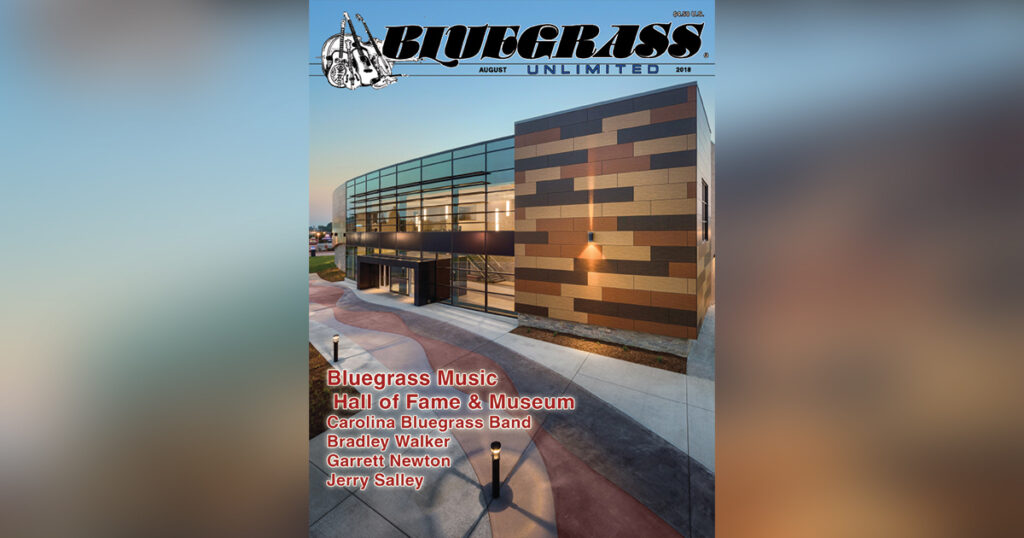
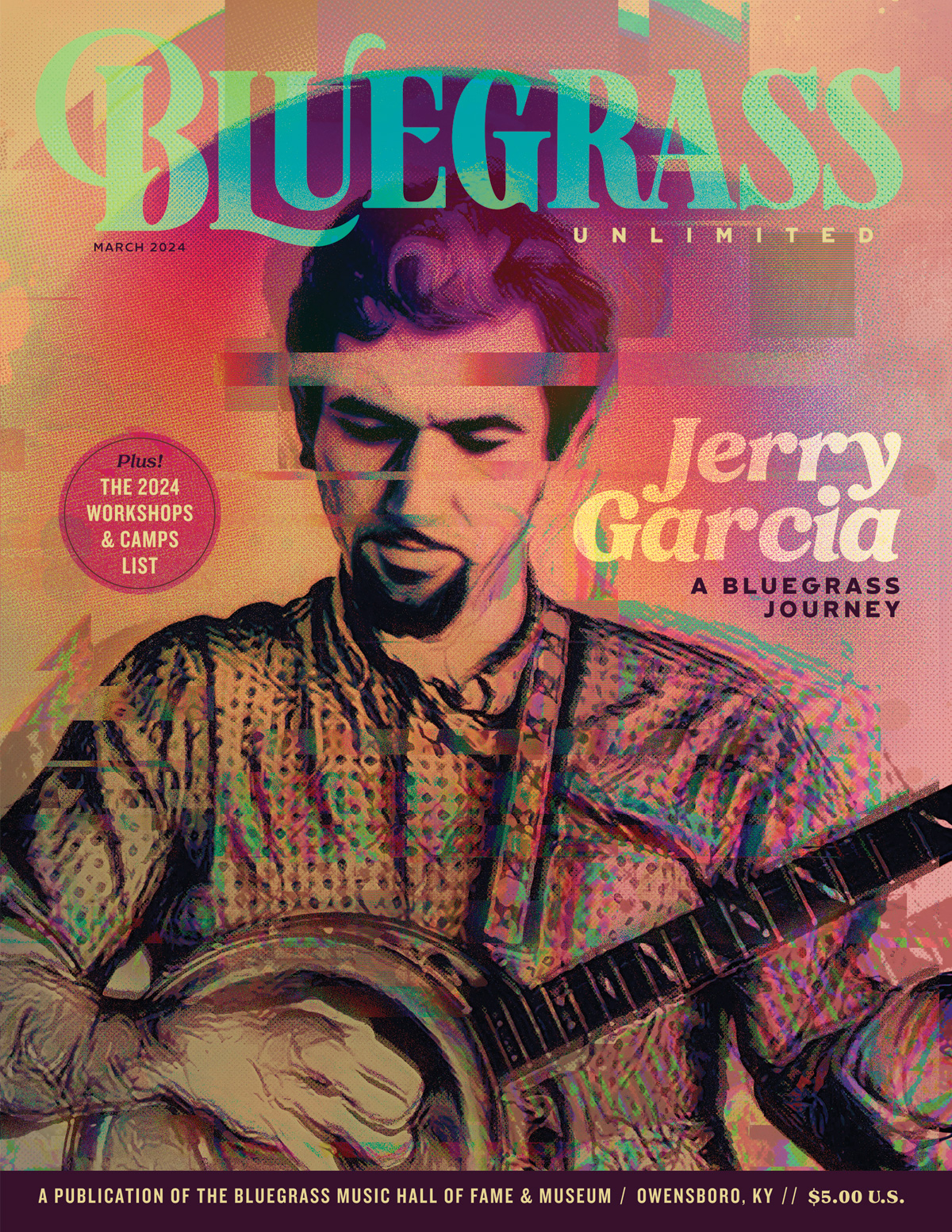
Let me know if you would like to be bequeathed my Kigut 5 String; her name is Ora, not Ora Lee,( long Heart-warming story )
Every good Music instrument deserves a ‘Good Home’ & be played .